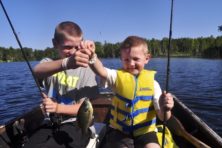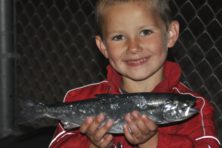Wild Things: Another Cheater on the Hook?
- Share
- Tweet
- Pin
- Share

Weights being found in fish in tournaments have made the news for years, but it took an X-ray to catch an alleged cheater who weighed a potential state record 4.07-pound white crappie in Kansas.
As it was, the angler might have gotten away with it if he didn’t have the giant in a freezer weeks later.
Bobby Parkhurst caught the lunker crappie April 4, 2023. At the time, it appeared to have broken the previous record of 4.02 pounds, set nearly six decades earlier in 1964.
But after certifying the record, the Kansas Department of Wildlife and Parks received a tip from an eyewitness who said that the crappie had been weighed at a different location at 3.73 pounds.
Game wardens met the angler, who voluntarily presented his fish for re-examination. A “beep” from a handheld metal detector meant a further inspection was warranted. Wardens took the fish to the Topeka Zoo, where an X-ray showed two steel ball bearings inside the crappie.
In a recent Facebook post, Parkhurst wrote that he caught the fish legally and honestly and referred to the officers as bullies.
Whatever the case, it makes one wonder how many of Wisconsin’s 50- to 80-plus-year-old state records were actually legit? Examples include walleye, smallmouth bass, muskie and brook trout. Records back then only needed a certified scale and a witness.
In my 40-plus years as a reporter, I’ve been at the scale when fisheries biologists inspected more than a half-dozen state record salmon and trout. All those fish were opened up and thoroughly checked after the weight was witnessed on a certified scale.
Could any or all of the oldest state records be legit? Certainly. But when you have an old-timer on his deathbed admitting that he added sand to win muskie-fishing contests more than a half-century ago, it makes me wonder what else was done by those looking just to get their name in the book.
I’m not really sure what year a state fisheries staffer had to personally witness and inspect a potential record fish, but I’m told many decades ago all that was needed was a certified scale and some witnesses. If the Wisconsin Department of Natural Resources knows the answer to that, I’m all ears. Maybe then there could actually be two separate records categories: inspected state records, and uninspected.
Either way, these are the Wisconsin state records that – to me, at least – will always seem a bit fishy:
• Tiger muskellunge (51 lbs., 3 oz., 1919)
• Walleye (18 lbs., 1933)
• Largemouth bass (11 lbs., 3 oz., 1940)
• Inland brook trout (9 lbs., 15 oz., 1944)
• Muskellunge (69 lbs., 11 oz., 1949)
• Smallmouth bass (9 lbs., 1-oz., 1950)
• Inland lake trout (35 lbs., 4 oz., 1957)
• Channel catfish (44 lbs., 1962)
• Common carp (57 lbs., 2 oz., 1966)
• Black crappie (4 lbs., 8 oz., 1967)
Bird Count Soars
More than 600,000 people from more than 200 countries or regions participated in the Great Backyard Bird Count Feb. 16-19, reporting an incredible 7,842 species from around the world.
Wisconsin was 36th among the states with 128 species seen or heard. Manitowoc County was sixth (59 species), Brown 12th (54), Door 18th (48), Outagamie 41st (26), Kewaunee 27th (41), Marinette 41st (30), and Oconto 55th (25). Manitowoc’s lakefront had the fourth-most species reported with 34 total.
Columbia topped the list of countries or regions with 1,348 species, followed by Ecuador (1,119), India (1,031), Brazil (1,001) and Peru (904). Mexico was next at 787, followed by Costa Rica (710), United States (672), Panama (664) and Argentina (652).
Participants shared more than 130,000 photos and sound recordings. You can check out some of them in a short video: youtube.com/watch?v=fBdJw7BUGuQ.
In addition, if you want to look up results from a particular area, check out this guide to using eBird to see results close to home: birdcount.org/explore-local-results/.
Spring(?) is Here
March 1 is the start of meteorological spring, which is based on the annual temperature cycle. Meteorological spring separates the coldest and warmest three-month periods of the year. It ends May 31.
Astronomical spring begins March 20 and ends June 21. It’s represented by Earth’s position relative to the sun. In other words, March 20 is the day when the sun’s highest point is directly over the equator before heading to the northern hemisphere.
The roller-coaster of warm and cold air we saw this week is likely to continue into March. While air temps will fluctuate, we’ll definitely need rain to make up for the lack of snowmelt that usually boosts Green Bay and Lake Michigan tributaries to aid spawning runs of pike, walleyes, rainbow trout and suckers.
Reduced bag limits and size restrictions for walleyes begin in early March; check the 2023-2024 guide to hook and line restrictions pamphlet for all the details, or look online at widnr.widen.net/s/fwdfffxqzv/fishingregselectronic2324.




